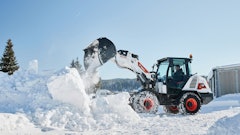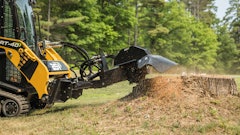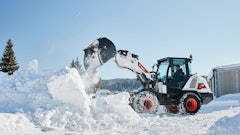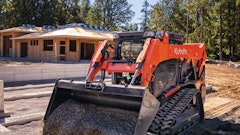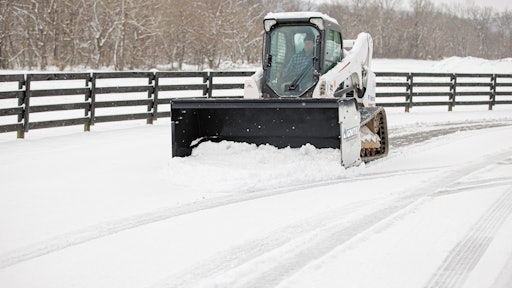
Big pieces of equipment completing big pushes of snow typically involve a big upfront investment.
“Your operation is unique. You have equipment needs that are specific to your fleet, your services and your area of operation,” says Darin Gronwold, senior product specialist for Ignite Attachments. “Asking questions and working through all the nuances of your operation before purchasing isn’t just a question of immediate finances; it helps ensure long-term profitability.”
To streamline the purchasing process for snow and ice professionals, three manufacturers offer up their best advice.
What to ask
Before having a conversation with a dealer or manufacturer, snow pros first need to ask themselves a few questions.
“Snow pros really should do a little bit of introspection to figure out what it is that they're looking for, so that they can then have that conversation around what is available,” says Erin Hunt, product manager for snow control, Douglas Dynamics.
First, snow pros need to understand what vehicles or equipment they’ll be using with the plow.
“The width and height of a snow plow will be 100% dependent on what you’re putting it on, so ask the dealer or manufacturer what the options are in terms of compatibility,” Hunt says.
Snow professionals should also have an idea of the types of properties they’ll be plowing and the plowing conditions, Hunt adds.
“If you’re plowing an apartment complex, that’s very different needs than for a parking lot,” Hunt says. “Also, know your conditions geographically. If you tend to have very heavy snow or a lot of ice, all of those will determine which path you go to.”
Craig Sandmann, manager director for Hilltip Corp., adds that snow professionals need to have a full understanding of their operational plan.
“Are they going to be relying, for example, solely on bulk material as the main anti-icing? Or preventive? Or are they going to use it in combination with liquids? Or is the dependence going to be predominantly on liquid anti-icing agents?” Sandmann asks. “What variety of material can a spreader handle? What type of conveyance system works best for those materials? What liquids are the pumps and filtration systems going to be able to handle?”
Additionally, Gronwold says snow professionals should check to be sure that the equipment is durable.
“Snow is heavy. Salt and other de-icers can be very corrosive,” Gronwold says. “Look for models with a reinforced frame that can withstand the weight of heavy snow as well as any impacts it might encounter. Finding equipment that is well-built yet cost-effective allows you to focus on your operation.”
Other questions to ask, Gronwold says, include:
- Are there any challenges or special considerations that will need to be accommodated? For example, will you be operating on delicate surfaces like turf?
- What is your budget?
- Will the manufacturer make a good partner today and in the future?
- How easy is it to get in touch with the manufacturer for service or support?
- Does the manufacturer make it easy to find solutions and resources? Are they responsive after purchase or just until they’ve made the sale?
- How does the manufacturer’s warranty program stack up to others in the industry?
- What does the manufacturer’s distribution look like? Are you able to get the attachments you need quickly or is there a backlog?
- Does the manufacturer have a reputation for quality products?
- What are other owners/operators saying about the durability or dependability of their products?
Timing
While the snow business really is a 365-day endeavor, Hunt says April through August is when a lot of contractors purchase equipment.
“That way, they can get it installed on their vehicle or piece of equipment in early fall, and they’re ready to go when the snow starts falling,” Hunt says.
Sandmann notes that in late spring and early summer, many manufacturers feature incentive programs that give dealers the best financial incentive to purchase equipment for stock for the coming season. Often, dealers can pass those savings on to their customers.
“It’s also the best time to buy because a lot of contractors are trying to renew contracts for the upcoming season, which may change the operational plan perspective of the business,” Sandmann says. “If you’re purchasing the equipment in late spring/early summer, that gives you time to onboard the equipment, train on the equipment and implement it into your overall operational plan.”
No matter the time snow pros purchase equipment, Gronwold says that the best time is before they actually need it.
“Understand your manufacturer’s distribution process to ensure equipment delivery ahead of winter weather,” Gronwold says. “It’s better to be prepared before the snow starts falling.”
Other recommendations
All other items considered, Gronwold, Hunt and Sandmann provide a few other pieces of recommendations about purchasing:
- Talk to people (both in person and through forums). Snow pros will find it most helpful to ask their peers and start building up their network.
- Most manufacturers’ websites incorporate a wealth of information. Read the available information and watch informational videos.
- Understand an area’s “hot button issues,” whether it’s liability insurance for slip and fall or environmental legislation.
- Environmental issues are becoming more important to customers, so in order to manage material usage, snow care operators must measure it. Often, technology is the most effective and accurate way to do so.
Trade shows
Snow professionals should remember that trade shows such as the Snow and Ice Symposium (SIMA) and Equip Expo offer the opportunity to speak with many manufacturers under one roof.
“You have the ability to speak with the engineers who are developing the product and the sales team who can help you understand pricing and budgets,” Hunt says. “It’s easy to compare all the options in a one-stop shop.”
Sandmann adds that those purchasing decisions all occur against the backdrop of the education sessions.
“Those can also help educate professionals as to the latest techniques and strategies on how best to tackle their winter operations,” Sandmann says.
Finally, Gronwold says that trade shows are a unique opportunity to connect directly with product experts and get answers to real-world questions.
“Walking a show can usually eliminate hours of research time since you can basically compare all your options side by side,” Gronwold says. “No driving all over town. No long email chains as you try to get in contact with the right person to answer your question.”





